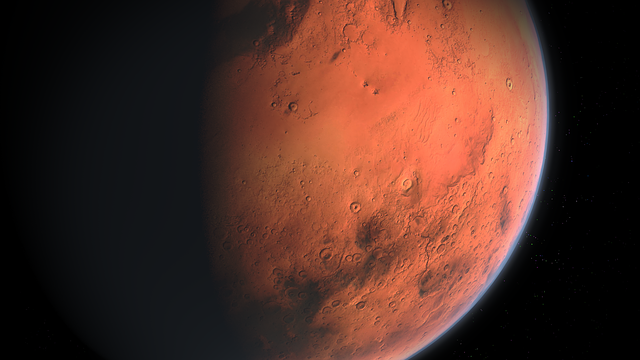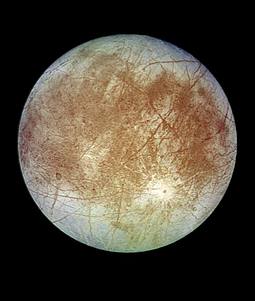*This post may contain affiliate links. This means we may make a commission if you purchase an item using one of our links*
The main differences between Mars and Europa would be that Mars is a normal terrestrial planet that orbits the Sun whilst Europa is the smallest of the Galilean moons that orbits Jupiter, Mars has 2 moons whilst Europa has 0 and Europa is colder on average with temperatures around -160°C whereas Mars averages -60°C on its surface.
There are numerous other differences and even a fair few similar features between Mars and Europa so, continue reading if you’re after a more thorough breakdown of each celestial body, their similarities as well as the differences between the two.
What Is The Planet Mars?
Table of Contents

Mars, also known as the red planet, is the celestial object that’s the front runner in our entire solar system to become a possible new home for us if terraformed. It is also the 4th farthest planet from the Sun and is one of 4 main line terrestrial planets (not including Pluto) in our solar system.
This means that one year on Mars will take roughly 687 Earth days and a day on Mars is roughly the same as Earth at 24 hours and 37 minutes. It’s axial tilt is also very similar to that of Earth where it is positioned around 25 degrees to the right.
It may not be the largest terrestrial world in our solar system as its diameter is only 6,779km but, it does have the most moons amongst the normal terrestrial planet where two, namely Deimos and Phobos, are currently orbiting the red planet.
Like Earth and the other terrestrial worlds, Mars does have an atmosphere, certainly more visible than that on Mercury but, when compared to Earth’s it is merely 1% of its volume.
As a result it is more susceptible to larger debris striking its surface and is unable to trap in too much heat either. This is why it’s on the colder side with a temperature of around -65 degrees Celsius on average. On the contrary its core is significantly hotter at 1,350 degrees Celsius.
Mars is probably the most explored planet outside of our own, with a multitude of rovers like Sojourner (1997–1997), Opportunity (2004–2018), Spirit (2004–2010), Curiosity (2012–), and Perseverance (2021–) that have landed on the Martian soil to explore it.
Billionaires like Elon Musk and even Jeff Bezos are trying for an opportunity to genuinely have astronauts land on the Martian soil, possibly as early as 2029 so, Mars clearly has a lot interested in its terrain, as a potential substitute for Earth in the future.
What Is The Moon Europa?

Europa is the smallest of the Galilean moons, first discovered on 8th January 1610. The surface of this icy world is frozen, but scientists believe a watery ocean could lie beneath the surface. And in 2012, researchers found a possible water plume in the Southern polar region of Europa.
This research is yet to be confirmed; still, it gives us reasonable grounds to hypothesize that water could exist on this icy moon.
Estimates place Europa at around 4.5 billion years old (the same age as its planet, Jupiter), and its average distance from the Sun is approximately 780 million km.
It has a diameter of 3,121.6km, which makes it larger than pluto but smaller than the Earth’s moon, and the maximum temperature is a chilly -160 degrees Celsius. In regards to mass, it measures in around 4.8 × 10^22 kg.
Europa takes three-and-a-half days to orbit its planet at an average distance of 670,900km, and it is tidally locked, meaning the same side of the moon always faces Jupiter.
Among the fascinating features of this ice moon is its incredibly reflective nature. The icy crust of this body provides a light reflectivity of 0.64 – the highest of any moon in the solar system.
Data from the Galileo spacecraft suggests that Europa is composed of an iron core, rocky mantle, and silicate rock (a similar composition to Earth).
The moon’s surface is covered in cracks, which many theorize could result from tidal currents beneath the surface. It is this potential of water – and of life – that keeps astronomers so interested in this moon.
Europa might be small, but astronomers estimate it holds two to three times more water than the Earth. In addition, this moon possesses the essential elements for life, such as carbon, oxygen, hydrogen, and nitrogen.
There may be no solar energy on this moon, but hydrothermal vents could provide energy, and tidal heating from Jupiter could provide a heat source and keep the moon stable enough for life to form. In addition, the liquid ocean is well protected from radiation from thick, icy surfaces.
How Are Mars And Europa Similar?
The similarities between Mars and Europa include the following:
- Both have a hotter central core.
- Both are a spherical in shape.
- Both are terrestrial based celestial bodies
- Both have an atmosphere and a rocky surface.
- Neither are tidally locked to the Sun.
- Both have no rings surrounding them.
- Both have water ice on their surfaces.
- Neither have tectonic plates.
- Neither have a magnetosphere.
- Both orbit their respective objects elliptically.
Differences Between Mars And Europa
In regards to the differences between these two entities, they would include the below:
- Mars is an official planet that orbits the Sun whilst Europa is one of Jupiter’s many natural satellites.
- Europa has 0 other moons orbiting it whilst Mars has 2.
- Europa is tidally locked to Jupiter whereas Mars is not tidally locked to any other entity.
- Mars is the 4th farthest entity from the Sun meaning it will take it 687 days to orbit the Sun whereas Europa does this in 12 years just like Jupiter whereas an orbit around Jupiter itself takes 3.55 days.
- A day on Mars is 24 hours and 37 minutes whilst a day on Europa is 3.5 days.
- Mars is the bigger of the two with a diameter of 6,779km whereas Europa has a diameter of 3,121.6km.
- Mars is quite cold on average with temperatures hitting around -65 degrees Celsius but Europa is colder still with an average of -160 degrees Celsius.
- Europa’s surface consists mostly of water ice and rock whilst Mars’ surface is mostly filled with rock and red sand along with ices around the poles.
- Mars has a density of 3.93 g/cm³ which is more than Europa’s that is 3.01 g/cm³.
- Europa’s mass is 4.8 × 10^22 kg, which is less than Mars’ that is 6.39 × 10^23 kg.
- Mars’ gravitational strength is 3.721 m/s² whilst Europa’s is far weaker being 1.315 m/s².
- Mars has an atmosphere that is 1% of Earth’s whilst Europa’s atmosphere is virtually non-existent.
- Mars has an axial tilt of 25 degrees whilst Europa’s is extremely straight at 0.1 degrees.
Summary
Even though Mars and Europa share various features such as the lack of plate tectonics, no magnetosphere and their general terrestrial composition, the two differ quite significantly still.
Whether it be in regards to their temperature, size, gravitational strength, their surfaces and beyond. Ultimately the two do function distinctly from one another, after all Mars is a planet with 2 moons orbiting it whilst Europa is simply one of Jupiter’s 79 moons.

